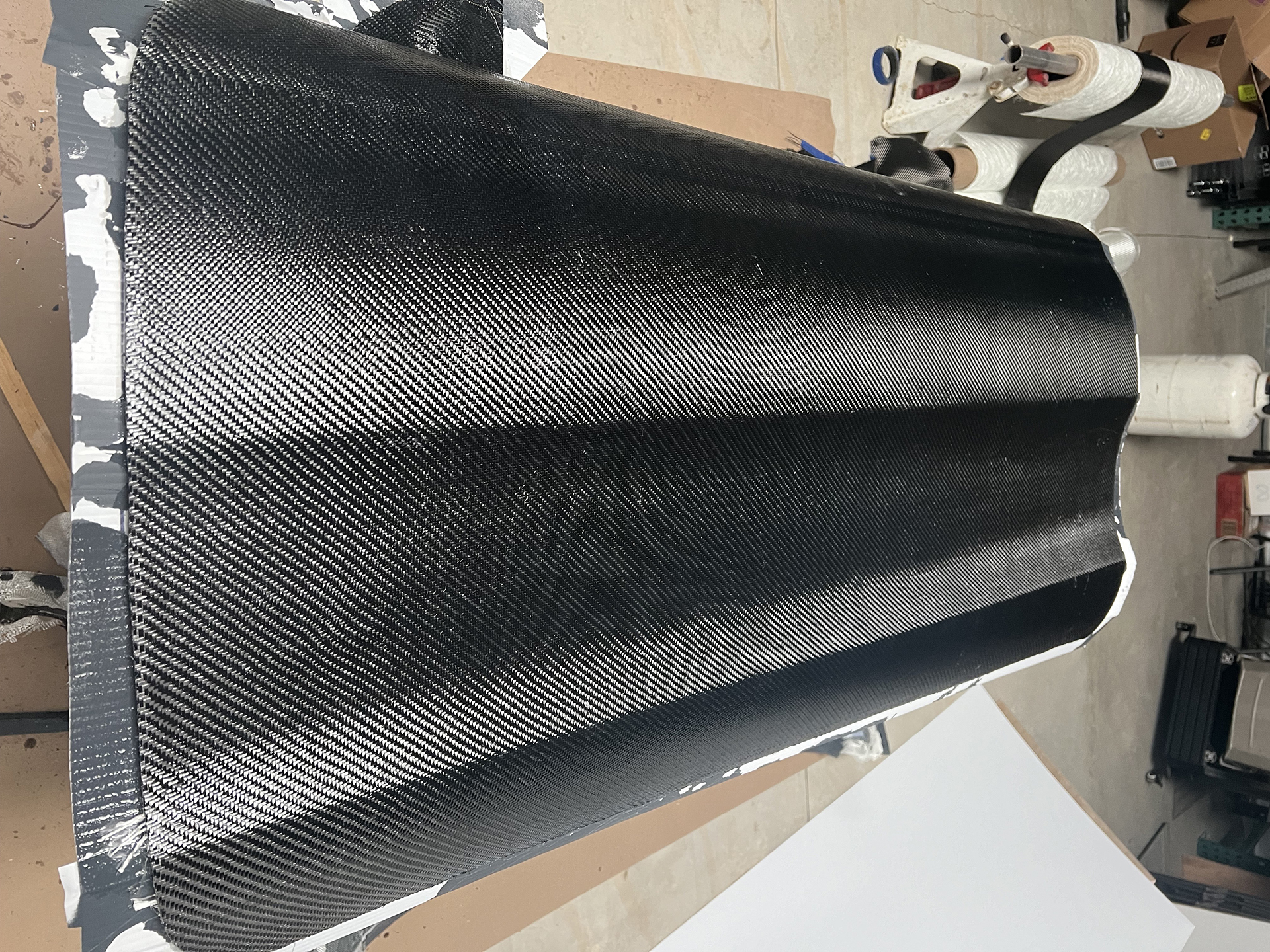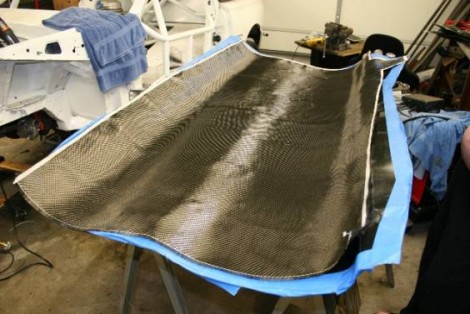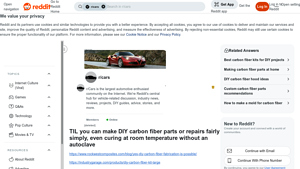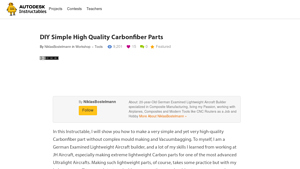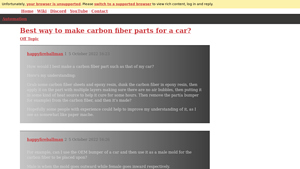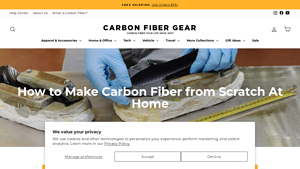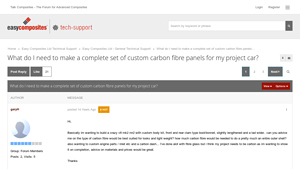Making Carbon Fiber Parts Guide: Type, Cost, Top List…
Introduction: Navigating the Global Market for making carbon fiber parts
In an era where lightweight, high-strength materials are paramount, navigating the global market for making carbon fiber parts presents both opportunities and challenges for B2B buyers. Sourcing high-quality carbon fiber components can be daunting, especially when considering the diverse applications across industries such as aerospace, automotive, and healthcare. This guide aims to demystify the complexities of carbon fiber part manufacturing by covering essential topics, including various types of carbon fiber materials, production methods, and practical applications tailored to meet specific industry needs.
International B2B buyers from regions like Africa, South America, the Middle East, and Europe, including key markets such as Saudi Arabia and Germany, will find actionable insights that empower informed purchasing decisions. The guide delves into supplier vetting processes, cost factors, and innovative manufacturing techniques, ensuring that businesses can identify reliable partners and optimize their procurement strategies.
By understanding the nuances of carbon fiber part production—from layup methods to resin selection—buyers can make strategic choices that enhance their product offerings while maintaining competitive pricing. Ultimately, this comprehensive resource equips decision-makers with the knowledge needed to thrive in a rapidly evolving market, fostering successful collaborations and sustainable growth.
Understanding making carbon fiber parts Types and Variations
| Type Name | Key Distinguishing Features | Primary B2B Applications | Brief Pros & Cons for Buyers |
|---|---|---|---|
| Wet Lay-Up | Manual application of resin onto dry fibers; low equipment cost | Aerospace, Automotive, Sports | Pros: Cost-effective; Cons: Labor-intensive; quality varies. |
| Prepreg Lamination | Pre-impregnated fibers; requires autoclave for curing | High-performance aerospace, Medical | Pros: Consistent quality; Cons: Higher cost; requires specialized equipment. |
| Resin Transfer Molding (RTM) | Automated, high-pressure injection of resin; two-part mold | Marine, Automotive, Industrial | Pros: Suitable for high-volume production; Cons: Initial setup cost can be high. |
| 3D Printed Molds | Uses 3D printing for complex mold designs; fast prototyping | Prototyping, Custom parts | Pros: Reduces lead time; Cons: May have limitations in material properties. |
| Hand Lay-Up | Similar to wet lay-up but focuses on manual layering techniques | Custom, Low-volume applications | Pros: Flexible and adaptable; Cons: Time-consuming; skill-dependent. |
What Are the Characteristics of Wet Lay-Up Carbon Fiber Manufacturing?
Wet lay-up is a straightforward method where dry carbon fiber sheets are layered in a mold, and resin is applied using brushes or rollers. This technique is particularly suited for low-volume production and prototyping, making it an attractive option for small businesses or startups in industries like aerospace and automotive. Buyers should consider the skill level required, as achieving high-quality results demands experience and attention to detail. While the initial investment is low, the labor intensity may affect overall project timelines.
How Does Prepreg Lamination Enhance Carbon Fiber Part Quality?
Prepreg lamination involves using pre-impregnated carbon fiber sheets that are cured in an autoclave. This method ensures precise resin content and superior mechanical properties, making it ideal for high-performance applications in aerospace and medical industries. B2B buyers should evaluate the cost implications and the need for specialized equipment, as this method is more expensive than wet lay-up. However, the consistent quality and performance benefits often justify the investment for critical applications.
What Are the Advantages of Resin Transfer Molding (RTM)?
Resin transfer molding (RTM) is an automated process that injects resin into a closed mold containing dry fiber. This technique is well-suited for high-volume production in sectors like marine and automotive. Buyers should consider the initial setup costs, which can be significant, but the benefits of reduced cycle times and consistent part quality can lead to lower overall production costs in the long run. RTM is particularly advantageous when manufacturing complex geometries that require precise material distribution.
Why Choose 3D Printed Molds for Carbon Fiber Parts?
3D printed molds represent a modern approach to carbon fiber manufacturing, allowing for rapid prototyping and complex designs that traditional methods struggle to achieve. This method is particularly beneficial for businesses needing custom parts or short production runs. While it can significantly reduce lead times, buyers should be aware of potential limitations regarding the strength and durability of the molds compared to traditional materials. Evaluating the specific requirements of the project will help determine if this method aligns with production goals.
How Does Hand Lay-Up Compare in Terms of Flexibility and Cost?
Hand lay-up is a variation of wet lay-up that emphasizes the manual layering of materials to create custom parts. This method offers high flexibility and can be adapted for unique designs or low-volume applications, making it suitable for niche markets. Buyers should consider the time commitment and skill level required, as the quality of the final product heavily relies on the expertise of the manufacturer. While it may not be the most efficient for large-scale production, hand lay-up can provide cost-effective solutions for specialized projects.
Key Industrial Applications of making carbon fiber parts
| Industry/Sector | Specific Application of making carbon fiber parts | Value/Benefit for the Business | Key Sourcing Considerations for this Application |
|---|---|---|---|
| Aerospace | Aircraft components such as wing structures and fuselages | Reduced weight leading to improved fuel efficiency and performance | Compliance with aviation standards and certifications |
| Automotive | High-performance racing car parts like body panels and chassis | Enhanced speed and agility due to lightweight construction | Need for precision engineering and rapid prototyping |
| Sports Equipment | Bicycles and sports gear including frames and helmets | Increased durability and performance while reducing weight | Sourcing from specialized manufacturers with expertise in composite materials |
| Renewable Energy | Wind turbine blades and components | Improved energy efficiency and longevity of equipment | Must meet stringent environmental and performance standards |
| Medical Devices | Prosthetics and orthopedic devices | Customizable, lightweight solutions that improve patient mobility | Compliance with health regulations and biocompatibility requirements |
How is Carbon Fiber Used in Aerospace Applications?
In the aerospace sector, carbon fiber parts are crucial for manufacturing lightweight yet strong components such as wing structures and fuselages. This application addresses the industry’s need for fuel efficiency and performance enhancement, as carbon fiber is significantly lighter than traditional materials like aluminum. International buyers, particularly from regions like Europe and the Middle East, must ensure that suppliers comply with stringent aviation standards and certifications to guarantee safety and reliability in flight operations.
What Role Does Carbon Fiber Play in the Automotive Industry?
In the automotive industry, carbon fiber is increasingly utilized in high-performance racing car parts, including body panels and chassis. The lightweight nature of carbon fiber allows for improved speed and agility, making it a preferred choice for manufacturers aiming to enhance vehicle performance. B2B buyers from South America and Africa should focus on sourcing from manufacturers that specialize in precision engineering and rapid prototyping to meet the fast-paced demands of the automotive market.
How is Carbon Fiber Enhancing Sports Equipment?
Carbon fiber’s application in sports equipment, particularly in bicycles and helmets, revolutionizes the industry by providing increased durability and performance while significantly reducing weight. This is particularly beneficial for competitive athletes who rely on equipment that can withstand high stress while enhancing their performance. Buyers in this sector should prioritize sourcing from manufacturers with a proven track record in composite materials, ensuring high-quality production that meets specific performance metrics.
Why is Carbon Fiber Important for Renewable Energy Solutions?
In renewable energy, carbon fiber is utilized in the production of wind turbine blades and components. The material’s lightweight and robust characteristics contribute to improved energy efficiency and the longevity of equipment, thereby supporting sustainable energy initiatives. Buyers in this sector must consider suppliers who adhere to stringent environmental and performance standards to ensure the sustainability and efficiency of their energy solutions.
How are Medical Devices Benefiting from Carbon Fiber Technology?
The medical device industry leverages carbon fiber in creating prosthetics and orthopedic devices, where lightweight and customizable solutions are paramount for enhancing patient mobility. This application solves the problem of bulky traditional materials, offering patients a more comfortable and functional experience. B2B buyers must ensure that their suppliers comply with health regulations and biocompatibility requirements, making it essential to source from reputable manufacturers with expertise in medical-grade composites.
3 Common User Pain Points for ‘making carbon fiber parts’ & Their Solutions
Scenario 1: Difficulty in Achieving Consistent Quality in Carbon Fiber Parts
The Problem: One of the most pressing challenges B2B buyers face when manufacturing carbon fiber parts is achieving consistent quality across production batches. Variability in raw materials, such as the type and quality of carbon fiber and resin, can lead to parts that do not meet specifications, which in turn affects performance and safety. This inconsistency can be particularly detrimental in industries such as aerospace or automotive, where even minor deviations can result in costly recalls or safety issues.
The Solution: To mitigate quality issues, buyers should establish robust sourcing protocols for raw materials. It’s crucial to partner with reputable suppliers who provide detailed certifications for their carbon fiber and resin products. Implementing a quality assurance (QA) program that includes testing samples from each batch can help identify discrepancies early in the production process. Additionally, investing in training for technicians on best practices for layup and curing processes will ensure that all team members are aligned on quality standards. Regular audits of both suppliers and internal processes can further enhance consistency.
Scenario 2: High Production Costs Due to Inefficient Manufacturing Processes
The Problem: Many companies find themselves grappling with high production costs when manufacturing carbon fiber parts. This often stems from inefficient processes, excessive material waste, and the need for specialized tooling and equipment, which can be particularly burdensome for smaller manufacturers or those in developing markets. These factors can severely impact profitability and competitiveness in a global market.
The Solution: To address these cost challenges, companies can adopt a lean manufacturing approach. By analyzing workflows to identify bottlenecks and areas of waste, manufacturers can streamline operations. Utilizing 3D printing technology to create molds can significantly reduce costs associated with traditional mold-making techniques, allowing for rapid prototyping and adjustments without the need for expensive tooling. Furthermore, bulk purchasing agreements with suppliers can lower raw material costs. Investing in employee training on efficient techniques, such as prepreg lamination, can also lead to reduced cycle times and lower overall production costs.
Scenario 3: Navigating Regulatory Compliance and Safety Standards
The Problem: Compliance with local and international safety and quality regulations is a significant concern for B2B buyers in the carbon fiber industry. This is especially true in regions like Europe and North America, where strict standards govern the use of composite materials in critical applications. Navigating these regulations can be overwhelming, leading to potential legal ramifications and financial penalties for non-compliance.
The Solution: To effectively navigate regulatory requirements, companies should develop a comprehensive compliance strategy. This includes staying informed about relevant regulations, such as those set forth by the European Union (EU) or the Federal Aviation Administration (FAA) in the U.S. Engaging with legal experts or compliance consultants can provide clarity on specific requirements. Additionally, implementing an internal compliance team that regularly reviews processes and documentation can help ensure adherence to regulations. Establishing relationships with industry associations can also provide insights into best practices and emerging standards, keeping manufacturers ahead of compliance challenges.
Strategic Material Selection Guide for making carbon fiber parts
What are the Key Materials for Making Carbon Fiber Parts?
When selecting materials for manufacturing carbon fiber parts, it is essential to consider the properties and performance of both the fiber and the resin used. Here, we analyze four common materials used in the production of carbon fiber components, focusing on their characteristics, advantages, disadvantages, and specific considerations for international B2B buyers.
1. Carbon Fiber
Key Properties: Carbon fiber is known for its high strength-to-weight ratio, exceptional stiffness, and resistance to fatigue. It can withstand high temperatures (up to 300°C) and has excellent corrosion resistance.
Pros & Cons: The primary advantage of carbon fiber is its superior mechanical properties, making it ideal for high-performance applications like aerospace and automotive. However, it is relatively expensive compared to other materials, and its manufacturing process can be complex, requiring specialized techniques such as prepreg lamination or resin transfer molding.
Impact on Application: Carbon fiber is highly suitable for applications that demand lightweight and strong components, such as in the automotive and aerospace sectors. Its compatibility with various media makes it versatile across different industries.
Considerations for International Buyers: Buyers from regions like Europe and the Middle East should ensure compliance with industry standards such as ASTM and DIN for quality assurance. The high cost may also influence decisions, especially for large-scale production.
2. Epoxy Resin
Key Properties: Epoxy resin offers excellent adhesion, chemical resistance, and thermal stability. It typically has a high glass transition temperature, which enhances the performance of carbon fiber composites.
Pros & Cons: Epoxy resins are favored for their superior mechanical properties and durability, making them suitable for high-performance applications. However, they can be sensitive to mixing ratios and temperature variations, which may complicate the manufacturing process.
Impact on Application: The use of epoxy resin in carbon fiber parts significantly enhances their strength and durability, making them ideal for demanding applications like aerospace and automotive components.
Considerations for International Buyers: International buyers should be aware of the specific curing requirements and the need for proper handling to ensure quality. Compliance with safety standards, especially in regions with strict regulations like Germany, is crucial.
3. Polyester Resin
Key Properties: Polyester resin is known for its ease of use, low cost, and UV resistance. It typically has a lower tensile strength compared to epoxy but is still suitable for many applications.
Pros & Cons: The main advantage of polyester resin is its affordability and straightforward application process, making it accessible for smaller manufacturers. However, it has lower mechanical properties and durability compared to epoxy, limiting its use in high-performance applications.
Impact on Application: Polyester resin is often used in applications where cost is a significant factor, such as in consumer goods or less critical structural components.
Considerations for International Buyers: Buyers should consider local availability and pricing, as polyester resins are widely produced. However, they should also be mindful of the potential need for additional treatments to enhance performance in specific environments.
4. Vinyl Ester Resin
Key Properties: Vinyl ester resin combines the advantages of epoxy and polyester, offering good corrosion resistance and thermal stability. It generally has a higher strength than polyester but lower than epoxy.
Pros & Cons: Vinyl ester resin is a versatile option that balances cost and performance, making it suitable for a variety of applications. However, it has a limited shelf life and may require careful handling to ensure optimal performance.
Impact on Application: This resin is particularly beneficial in applications exposed to harsh environments, such as marine and chemical processing industries.
Considerations for International Buyers: Buyers should verify the compatibility of vinyl ester with local environmental regulations and standards. Understanding the resin’s properties can help in selecting the right material for specific applications.
Summary Table of Material Selection for Carbon Fiber Parts
| Material | Typical Use Case for making carbon fiber parts | Key Advantage | Key Disadvantage/Limitation | Relative Cost (Low/Med/High) |
|---|---|---|---|---|
| Carbon Fiber | Aerospace components, automotive parts | High strength-to-weight ratio | High cost and complex manufacturing process | High |
| Epoxy Resin | High-performance composites | Superior mechanical properties | Sensitive to mixing ratios and temperature | High |
| Polyester Resin | Consumer goods, non-critical components | Low cost and easy to apply | Lower mechanical properties than epoxy | Low |
| Vinyl Ester Resin | Marine and chemical processing applications | Good corrosion resistance | Limited shelf life and requires careful handling | Medium |
This strategic material selection guide provides valuable insights for international B2B buyers looking to manufacture carbon fiber parts, helping them make informed decisions that align with their specific needs and market conditions.
In-depth Look: Manufacturing Processes and Quality Assurance for making carbon fiber parts
What Are the Key Stages in Manufacturing Carbon Fiber Parts?
Manufacturing carbon fiber parts involves a meticulous process that ensures the final product meets the high-performance standards expected in industries such as aerospace, automotive, and healthcare. The primary stages include material preparation, forming, assembly, and finishing. Each stage is crucial for achieving the desired mechanical properties and surface quality.
How is Material Prepared for Carbon Fiber Manufacturing?
Material preparation is the foundational step in the manufacturing process. It begins with selecting the appropriate carbon fiber and resin type. Carbon fiber comes in various forms, such as woven fabrics or unidirectional sheets, each offering distinct advantages in terms of strength and flexibility. The choice of resin—epoxy, polyester, or vinyl ester—affects the part’s performance characteristics, including weight, strength, and curing time.
Once the materials are selected, they must be cut and arranged according to the part design. This often involves creating a layup schedule that dictates the orientation and layering of the fibers, which is crucial for achieving the desired mechanical properties. Advanced techniques such as 3D printing can be employed to create molds, optimizing material usage and reducing costs.
What Forming Techniques Are Commonly Used in Carbon Fiber Manufacturing?
The forming stage encompasses several techniques for integrating the carbon fiber with the resin. The most common methods include:
-
Wet Lay-Up: This manual technique involves laying dry fibers into a mold and applying resin using brushes or rollers. While labor-intensive, it is cost-effective for small production runs and prototyping.
-
Prepreg Lamination: In this method, fibers are pre-impregnated with resin and stored under refrigeration to prevent curing. When ready, the plies are placed in a heated mold and cured under pressure, ensuring a consistent resin-to-fiber ratio and superior mechanical properties.
-
Resin Transfer Molding (RTM): This automated process uses a two-part mold where dry fibers are placed and resin is injected under pressure. RTM is ideal for high-volume production due to its efficiency and repeatability.
Each method has its advantages and is chosen based on factors such as part complexity, production volume, and budget constraints.
What Assembly Processes Are Involved in Carbon Fiber Parts Manufacturing?
Once the individual components are formed, they may require assembly. This stage can involve bonding multiple layers or integrating additional elements such as inserts or connectors. Adhesives or mechanical fasteners may be used, depending on the design requirements.
Quality control during assembly is vital, as the integrity of joints and connections directly influences the performance of the final product. Specialized techniques, such as ultrasonic welding or heat staking, may also be employed to enhance joint strength without adding weight.
How is the Finishing of Carbon Fiber Parts Achieved?
Finishing is the final stage in the manufacturing process, where parts undergo surface treatment to achieve the desired aesthetic and functional qualities. This may include sanding, polishing, or applying surface coatings to enhance durability and resistance to environmental factors.
In some cases, finishing processes also involve inspecting the surface for defects, such as voids or delamination, which could compromise performance. It is crucial that the finished parts comply with industry standards for surface quality and performance.
What Quality Assurance Practices Should B2B Buyers Consider?
Quality assurance (QA) is an integral part of carbon fiber parts manufacturing, ensuring that products meet international and industry-specific standards. For B2B buyers, understanding the quality assurance framework is essential for making informed purchasing decisions.
Which International Standards Should Be Followed?
Manufacturers should adhere to international standards such as ISO 9001, which outlines quality management principles. Specific industries may also require compliance with standards like CE marking for products sold in Europe or API specifications for oil and gas applications.
Each standard provides a framework for ensuring consistent quality and safety, which is particularly important for components used in critical applications.
What Are the Key QC Checkpoints in Carbon Fiber Manufacturing?
Quality control checkpoints are established throughout the manufacturing process to ensure each stage meets predefined criteria. These typically include:
- Incoming Quality Control (IQC): Inspection of raw materials upon receipt to ensure they meet specifications.
- In-Process Quality Control (IPQC): Continuous monitoring during production to detect and address issues in real-time.
- Final Quality Control (FQC): Comprehensive testing of finished products against specified standards before shipment.
Common testing methods include tensile strength tests, impact tests, and visual inspections for defects.
How Can B2B Buyers Verify Supplier Quality Assurance?
B2B buyers should implement a rigorous vetting process when selecting suppliers. This includes:
- Audits: Conducting on-site audits to assess manufacturing processes and quality control systems.
- Reports: Requesting detailed quality assurance reports that outline compliance with relevant standards and the results of testing conducted.
- Third-Party Inspections: Engaging independent inspection services to verify that products meet specified requirements before shipment.
What Are the Nuances of Quality Control for International Buyers?
For international buyers, understanding the nuances of quality control is critical. Different regions may have varying regulatory requirements and standards. For instance, products destined for the European market must comply with CE marking requirements, which involve thorough documentation and testing.
Buyers from Africa and South America may face additional challenges due to differences in infrastructure and available technology. Therefore, establishing strong communication channels with suppliers and understanding local regulations is essential for ensuring product quality and compliance.
Conclusion
In conclusion, the manufacturing processes and quality assurance practices for carbon fiber parts are complex and require careful attention to detail. By understanding the key stages of production, the importance of quality assurance, and how to verify supplier capabilities, B2B buyers can make informed decisions and ensure they receive high-quality components that meet their needs. By prioritizing these factors, businesses can enhance their supply chains and improve their competitive edge in the global market.
Practical Sourcing Guide: A Step-by-Step Checklist for ‘making carbon fiber parts’
In the rapidly evolving landscape of composite materials, carbon fiber stands out due to its unique combination of strength and lightweight properties. This guide provides a step-by-step checklist for B2B buyers looking to source the necessary components and services for manufacturing carbon fiber parts. By following these steps, you can ensure a successful procurement process that meets your technical and quality requirements.
Step 1: Define Your Technical Specifications
Clearly outline the technical requirements for the carbon fiber parts you intend to manufacture. This includes dimensions, weight tolerance, load-bearing capacity, and environmental resistance. Establishing these specifications upfront will help you communicate effectively with suppliers and ensure that the materials and processes meet your project needs.
Step 2: Research and Identify Potential Suppliers
Conduct thorough research to identify suppliers that specialize in carbon fiber materials and manufacturing processes. Look for companies that have experience in your industry, whether it’s aerospace, automotive, or sports equipment. Pay attention to their product range, capabilities, and any specialized services they offer, such as custom mold fabrication or pre-preg lamination.
Step 3: Evaluate Supplier Certifications and Quality Standards
Before making a decision, verify that potential suppliers adhere to relevant industry standards and certifications. This may include ISO certifications, quality assurance protocols, and environmental compliance. Suppliers with recognized certifications are more likely to provide consistent quality and reliability, which is crucial for maintaining your production schedule and product integrity.
Step 4: Request Samples and Test Materials
Always request samples of the carbon fiber materials and components you plan to use. Conduct tests to assess their performance, such as tensile strength and flexibility, to ensure they meet your specifications. Evaluating samples before placing a bulk order can prevent costly mistakes and ensure that the materials will perform as expected in your applications.
Step 5: Understand Lead Times and Production Capabilities
Discuss lead times and production capabilities with your shortlisted suppliers. Understanding their manufacturing processes, capacity for scaling production, and potential delays will help you align your project timelines. Suppliers who can provide clear timelines and have a proven track record of meeting deadlines are preferable.
Step 6: Negotiate Pricing and Payment Terms
Once you have identified a suitable supplier, engage in negotiations regarding pricing and payment terms. Ensure that you understand the cost structure, including any additional fees for custom work or expedited shipping. Establishing favorable payment terms can improve your cash flow and strengthen your partnership with the supplier.
Step 7: Establish Clear Communication Channels
Finally, set up clear communication channels with your chosen supplier. Regular updates on production progress, quality checks, and any issues that arise will foster a strong working relationship. Open communication is key to addressing any concerns promptly and ensuring the success of your carbon fiber parts manufacturing project.
By following these steps, B2B buyers can effectively navigate the sourcing process for carbon fiber parts, ensuring high-quality outcomes that meet their specific needs.
Comprehensive Cost and Pricing Analysis for making carbon fiber parts Sourcing
What Are the Key Cost Components in Making Carbon Fiber Parts?
When sourcing carbon fiber parts, understanding the cost structure is essential for effective budgeting and negotiation. The primary cost components include:
-
Materials: The choice of fibers and resins significantly impacts costs. Carbon fiber, while offering superior strength-to-weight ratios, is generally more expensive than alternatives like fiberglass. Epoxy resins are often the preferred choice for high-performance applications but come with a higher price tag compared to polyester or vinyl ester resins.
-
Labor: Skilled labor is crucial in the manufacturing process, especially given the intricate techniques involved in carbon fiber layup and molding. Labor costs can vary widely based on regional wage standards and the complexity of the part being produced.
-
Manufacturing Overhead: This includes the costs associated with running manufacturing facilities, such as utilities, equipment maintenance, and administrative expenses. Overhead can be minimized through efficient production processes and facility management.
-
Tooling: Molds are a significant investment in carbon fiber production. Depending on the method (e.g., prepreg lamination, wet lay-up), tooling costs can range from low for simple molds made of foam to high for intricate, precision-engineered molds.
-
Quality Control (QC): Ensuring that parts meet industry standards involves testing and inspection, which adds to the overall cost. The level of QC required can influence both the manufacturing process and the final price.
-
Logistics: Shipping costs can be considerable, especially for international buyers. Factors such as distance, mode of transport, and customs duties play a vital role in determining logistics costs.
-
Margin: Suppliers typically include a profit margin in their pricing. This margin can vary based on market conditions, competition, and the supplier’s business model.
How Do Volume and Customization Affect Pricing for Carbon Fiber Parts?
The volume of parts ordered and the level of customization required are significant price influencers in the carbon fiber market.
-
Volume/MOQ: Suppliers often have minimum order quantities (MOQs), which can lead to economies of scale. Larger orders typically result in lower per-unit costs, as fixed costs are spread over a greater number of units. Conversely, smaller orders may incur higher costs due to less efficient production runs.
-
Specifications and Customization: Custom designs or specialized materials can increase costs. Buyers should be clear about their specifications upfront to avoid additional charges for design alterations later in the process.
What Are the Buyer Tips for Negotiating Carbon Fiber Parts Pricing?
When negotiating with suppliers, international buyers should consider several strategies to enhance cost-efficiency:
-
Total Cost of Ownership (TCO): Evaluate not just the initial cost of the parts, but also the long-term implications, including maintenance, performance, and potential failures. A lower upfront price might not always equate to better value.
-
Supplier Relationships: Building strong relationships with suppliers can lead to better pricing and terms. Regular communication and trust can result in more favorable conditions.
-
Explore Incoterms: Understanding Incoterms (International Commercial Terms) can help buyers manage shipping costs and responsibilities. Selecting the right terms can significantly affect the total landed cost of the parts.
-
Market Research: Conduct thorough research on supplier options, material costs, and market trends. Being well-informed can provide leverage in negotiations.
-
Quality Certifications: Ensure suppliers have the necessary quality certifications relevant to your industry. This can justify higher prices due to the assurance of quality and compliance with regulations.
Are There Pricing Nuances for International B2B Buyers in Different Regions?
International buyers, particularly from regions like Africa, South America, the Middle East, and Europe, should be aware of specific pricing nuances. Currency fluctuations, import tariffs, and local market conditions can influence costs. It’s advisable to work with suppliers who understand these regional dynamics and can provide tailored solutions.
Disclaimer for Indicative Prices
Please note that prices for carbon fiber parts can fluctuate based on a variety of factors including market demand, material availability, and production methodologies. It is essential for buyers to obtain quotes specific to their needs and to regularly review market conditions.
Alternatives Analysis: Comparing making carbon fiber parts With Other Solutions
Introduction to Alternatives in Manufacturing
When considering the manufacturing of lightweight, high-performance parts, carbon fiber is often the material of choice due to its superior strength-to-weight ratio. However, there are several alternative materials and methods that can also achieve similar performance goals. This analysis will provide a comparative overview of making carbon fiber parts against two viable alternatives: fiberglass reinforced plastics (FRP) and aluminum machining. Understanding the strengths and weaknesses of these options will help B2B buyers make informed decisions based on their specific requirements.
Comparison Table
| Comparison Aspect | Making Carbon Fiber Parts | Fiberglass Reinforced Plastics (FRP) | Aluminum Machining |
|---|---|---|---|
| Performance | High strength and stiffness; lightweight; ideal for high-performance applications | Moderate strength; heavier than carbon fiber but versatile | Strong and durable; good for structural applications |
| Cost | High initial cost; expensive raw materials and manufacturing processes | Lower cost than carbon fiber; more budget-friendly | Moderate to high cost; machining can be expensive |
| Ease of Implementation | Requires skilled labor; complex processes like lay-up or autoclaving | Easier to work with; can be done with basic tools | Requires specialized machinery and expertise |
| Maintenance | Low maintenance; durable under various conditions | Moderate; can be prone to UV degradation | Low; high durability but can corrode |
| Best Use Case | Aerospace, automotive, and high-performance sporting goods | Marine applications, consumer goods, and construction | Structural components, automotive, and aerospace |
Detailed Breakdown of Alternatives
Fiberglass Reinforced Plastics (FRP)
Fiberglass reinforced plastics are a popular alternative due to their lower cost and greater ease of manufacturing. FRP materials are created by embedding glass fibers within a resin matrix, resulting in a composite that is both lightweight and strong. This method is less labor-intensive than carbon fiber production, making it more accessible for companies with limited resources. However, while fiberglass is versatile and suitable for a variety of applications, it does not match the performance characteristics of carbon fiber, particularly in high-stress environments. Additionally, FRP can suffer from UV degradation over time, potentially requiring more frequent maintenance.
Aluminum Machining
Aluminum machining involves shaping aluminum alloys into parts using processes such as CNC machining or die casting. This method is well-established and widely used across various industries, offering a good balance of strength and weight. Aluminum is particularly suited for structural applications where durability is paramount. However, while aluminum parts can be produced quickly and efficiently, they tend to be heavier than carbon fiber components, which may be a disadvantage in performance-sensitive applications. Furthermore, the cost of machining can escalate with complexity, making it less cost-effective for lower volume production runs.
Conclusion: Choosing the Right Solution for Your Needs
In selecting the appropriate manufacturing method for lightweight, high-performance parts, B2B buyers should carefully evaluate their specific requirements, including performance, cost constraints, and ease of implementation. Carbon fiber parts are unmatched in strength-to-weight ratios, making them ideal for high-performance applications but may require a larger investment and skilled labor. On the other hand, fiberglass reinforced plastics offer a more budget-friendly and easier-to-manufacture option, while aluminum machining provides excellent strength but at the cost of increased weight. By weighing these factors, buyers can make informed decisions that align with their operational goals and market demands.
Essential Technical Properties and Trade Terminology for making carbon fiber parts
What Are the Key Technical Properties of Carbon Fiber Parts?
When considering carbon fiber parts for manufacturing, understanding the essential technical specifications is critical. These properties not only influence the performance and durability of the parts but also affect manufacturing processes and cost. Here are some key specifications:
-
Material Grade
The material grade of carbon fiber determines its strength, stiffness, and weight characteristics. Common grades include standard modulus (SM) and intermediate modulus (IM), with higher modulus fibers providing increased stiffness. For B2B buyers, selecting the right material grade is vital to ensure that the part meets specific application requirements while optimizing costs. -
Tensile Strength
This property indicates the maximum stress a material can withstand while being stretched or pulled before failing. Carbon fiber typically exhibits tensile strengths ranging from 350 to over 600 MPa (megapascals), making it significantly stronger than traditional materials like steel. Understanding tensile strength is essential for buyers in industries such as aerospace and automotive, where performance and safety are paramount. -
Flexural Modulus
Flexural modulus measures a material’s ability to resist deformation under load. High flexural modulus values in carbon fiber mean that parts can maintain shape and performance under stress. B2B buyers must consider this property to ensure parts will endure operational loads without compromising structural integrity. -
Thermal Conductivity
Carbon fiber has relatively low thermal conductivity, which can be beneficial in applications requiring thermal insulation. Buyers should assess this property based on their specific application needs, especially in industries where temperature variations can affect performance. -
Weight-to-Strength Ratio
This ratio is crucial in industries where reducing weight is essential, such as aerospace and automotive. Carbon fiber offers a superior weight-to-strength ratio compared to metals, allowing for lighter, more efficient designs. Understanding this ratio helps buyers justify the investment in carbon fiber over traditional materials.
What Common Trade Terms Should B2B Buyers Understand?
Navigating the carbon fiber industry involves familiarizing oneself with specific trade terminology. Understanding these terms can facilitate smoother transactions and improve communication with suppliers.
-
OEM (Original Equipment Manufacturer)
An OEM refers to a company that produces parts or equipment that may be marketed by another manufacturer. In the carbon fiber industry, OEMs often require custom components tailored to their specifications. Knowing about OEM relationships is essential for buyers who need specialized parts for their products. -
MOQ (Minimum Order Quantity)
MOQ is the smallest quantity of a product that a supplier is willing to sell. Understanding MOQ is crucial for B2B buyers, as it affects inventory costs and cash flow. Buyers should negotiate MOQs that align with their project needs and budget constraints. -
RFQ (Request for Quotation)
An RFQ is a document issued by a buyer to solicit price quotations from suppliers for specific goods or services. This process is vital for obtaining competitive pricing and understanding the cost structure associated with carbon fiber parts. Buyers should prepare comprehensive RFQs to ensure accurate and comparable quotes. -
Incoterms
International Commercial Terms (Incoterms) are a set of rules that define the responsibilities of buyers and sellers in international transactions. Familiarity with Incoterms helps buyers understand shipping costs, risk management, and insurance responsibilities, ensuring clarity in contracts and negotiations. -
CNC Machining
CNC (Computer Numerical Control) machining refers to the automated process of using computers to control machine tools. This technology is often employed in the production of carbon fiber molds and components. Buyers should recognize the advantages of CNC machining, including precision and repeatability, which are crucial for high-quality carbon fiber parts. -
Prepreg
Prepreg refers to pre-impregnated composite fibers that are combined with a resin system. This material is known for its consistent resin-to-fiber ratio, leading to improved performance characteristics. Understanding prepreg is vital for buyers seeking high-performance applications, as it influences manufacturing methods and end-product quality.
By grasping these essential technical properties and trade terminologies, B2B buyers can make informed decisions that enhance their manufacturing processes and ensure they select the right carbon fiber parts for their specific needs.
Navigating Market Dynamics and Sourcing Trends in the making carbon fiber parts Sector
What Are the Key Drivers and Trends in the Global Carbon Fiber Parts Market?
The carbon fiber parts market is experiencing robust growth driven by advancements in manufacturing technologies and an increasing demand for lightweight, high-performance materials across various industries. Key sectors include aerospace, automotive, and sports equipment, where carbon fiber’s superior strength-to-weight ratio offers significant advantages. Furthermore, the rise of electric vehicles (EVs) and renewable energy technologies is amplifying demand for carbon fiber components that enhance efficiency and reduce weight.
Emerging technologies, such as 3D printing and automated carbon fiber layup processes, are reshaping sourcing strategies. These innovations not only streamline production but also lower costs, making carbon fiber more accessible to a broader range of manufacturers. For international B2B buyers, particularly those in Africa, South America, the Middle East, and Europe, understanding these technological trends is crucial for making informed sourcing decisions.
Additionally, the market dynamics are influenced by geopolitical factors and trade regulations. Buyers should remain vigilant about sourcing from stable regions and diversifying their supply chains to mitigate risks associated with global supply disruptions. As competition intensifies, companies that can leverage local suppliers and innovative manufacturing methods will have a distinct advantage.
How Can Sustainability and Ethical Sourcing Impact Your B2B Carbon Fiber Procurement?
Sustainability is becoming an integral consideration for B2B buyers in the carbon fiber sector. The environmental impact of carbon fiber production, including energy consumption and waste generation, necessitates a focus on sustainable practices. Buyers are increasingly seeking suppliers who employ eco-friendly manufacturing processes and materials, such as bio-based resins and recyclable fibers.
Ethical sourcing is equally important, as it addresses labor practices and the overall integrity of the supply chain. B2B buyers should prioritize suppliers with certifications that demonstrate commitment to sustainability, such as ISO 14001 for environmental management and certifications related to responsible sourcing of raw materials. Engaging with suppliers who have transparent supply chains can enhance brand reputation and ensure compliance with evolving regulations.
Incorporating sustainability into procurement strategies not only mitigates environmental risks but can also lead to long-term cost savings. For instance, using recycled carbon fiber can reduce material costs while simultaneously appealing to environmentally conscious consumers. As global awareness of sustainability grows, aligning procurement strategies with these values will be essential for maintaining a competitive edge.
What Is the Historical Context Behind Carbon Fiber Parts Manufacturing?
The evolution of carbon fiber parts manufacturing can be traced back to the mid-20th century when the material was first developed for aerospace applications. Initially, carbon fiber was primarily used in high-performance contexts due to its cost and complexity of production. Over the decades, advancements in manufacturing processes, such as the introduction of epoxy resins and improved weaving techniques, have made carbon fiber more versatile and cost-effective.
By the 1990s, carbon fiber began to penetrate consumer markets, particularly in sports and automotive applications, where performance enhancements were highly sought after. Today, the material is ubiquitous, utilized in everything from bicycles to industrial machinery. As technologies continue to evolve and global demand increases, the future of carbon fiber manufacturing looks promising, with opportunities for innovation and efficiency at the forefront of the industry’s evolution.
In summary, international B2B buyers must stay informed about market dynamics, embrace sustainability, and understand the historical context to navigate the complexities of sourcing carbon fiber parts effectively.
Frequently Asked Questions (FAQs) for B2B Buyers of making carbon fiber parts
-
How do I ensure the quality of carbon fiber parts from a supplier?
To ensure quality, start by requesting samples of the carbon fiber parts to evaluate their performance and finish. Look for suppliers with certifications such as ISO 9001, which indicates adherence to quality management standards. Additionally, inquire about their quality assurance processes, including material testing and inspection protocols. Visiting the supplier’s facility or seeking third-party audits can also provide insights into their manufacturing capabilities and commitment to quality. -
What is the best method for manufacturing carbon fiber parts for my application?
The best method depends on your specific application and production volume. For low-volume, high-quality prototypes, wet lay-up is cost-effective and flexible. For higher performance and consistency, prepreg lamination is ideal, though it is more expensive. For large-scale production, resin transfer molding (RTM) offers efficiency and repeatability. Evaluate your project’s requirements, including weight, strength, and budget, to select the most suitable method. -
What should I consider when negotiating payment terms with carbon fiber suppliers?
When negotiating payment terms, consider factors such as order size, supplier reliability, and your cash flow needs. Common terms include upfront deposits, payment upon delivery, or net 30/60 days. Be clear about the payment methods accepted and ensure they align with your financial processes. Establishing a good relationship with the supplier can lead to more favorable terms, especially for repeat orders. -
How can I verify the credibility of a carbon fiber parts supplier?
To verify a supplier’s credibility, conduct thorough background checks, including reviews from previous clients and industry reputation. Request references and contact them to discuss their experiences. Look for suppliers with industry certifications and a track record of compliance with international standards. Additionally, consider visiting their facility or utilizing third-party verification services to assess their manufacturing practices. -
What are the typical minimum order quantities (MOQs) for carbon fiber parts?
MOQs for carbon fiber parts can vary significantly based on the supplier and the manufacturing method. Generally, smaller suppliers may accommodate orders as low as 10-50 units, while larger manufacturers may require 100 or more units to justify production costs. Discuss your specific needs with potential suppliers to see if they can offer flexible MOQs, especially for initial orders or prototypes. -
How do I handle logistics and shipping for international orders of carbon fiber parts?
When handling logistics for international orders, consider the shipping methods, costs, and timelines. Work with a reliable freight forwarder who understands customs regulations and can assist with documentation. Ensure that the supplier is aware of your shipping preferences and that they package the parts securely to prevent damage. Discuss insurance options to protect your investment during transit, especially for high-value items. -
What customization options are typically available for carbon fiber parts?
Most suppliers offer various customization options, including size, shape, fiber orientation, and finish. You can also specify the type of resin used, which can affect the part’s performance characteristics. Discuss your specific requirements with the supplier to understand what options are available and any potential impacts on cost and lead time. Providing detailed specifications can help ensure the final product meets your expectations. -
What are the common applications for carbon fiber parts in different industries?
Carbon fiber parts are widely used in industries such as aerospace, automotive, and sports equipment due to their high strength-to-weight ratio. In aerospace, they enhance fuel efficiency and performance in aircraft structures. The automotive industry uses them in high-performance vehicles for weight reduction and improved handling. Additionally, sectors like healthcare utilize carbon fiber for prosthetics and medical devices, demonstrating its versatility across various applications.
Important Disclaimer & Terms of Use
⚠️ Important Disclaimer
The information provided in this guide, including content regarding manufacturers, technical specifications, and market analysis, is for informational and educational purposes only. It does not constitute professional procurement advice, financial advice, or legal advice.
While we have made every effort to ensure the accuracy and timeliness of the information, we are not responsible for any errors, omissions, or outdated information. Market conditions, company details, and technical standards are subject to change.
B2B buyers must conduct their own independent and thorough due diligence before making any purchasing decisions. This includes contacting suppliers directly, verifying certifications, requesting samples, and seeking professional consultation. The risk of relying on any information in this guide is borne solely by the reader.
Top 8 Making Carbon Fiber Parts Manufacturers & Suppliers List
1. Reddit – DIY Carbon Fiber Solutions
Domain: reddit.com
Registered: 2005 (20 years)
Introduction: DIY carbon fiber parts or repairs can be made fairly simply, curing at room temperature without an autoclave. Potential applications include custom light brackets and cold air intakes. The process involves wet layups, which can be messy and require a startup cost for materials. Making molds takes the longest time, while the actual layups are quick. 3D printing molds is possible but requires additi…
2. Instructables – DIY Carbon Fiber Parts
Domain: instructables.com
Registered: 2005 (20 years)
Introduction: DIY Simple High Quality Carbonfiber Parts by NiklasBostelmann; Tools and Materials: XPS Foam, Cardboard, Plastic Film, Duct Tape, Double-sided Tape, Paper Towel, Baking Paper, Carbon Fiber (160g/m2-200g/m2, 2×2 twill 80g/m2-120g/m2), Epoxy Resin; Tools for Mould Making: Scissors, Pens, Ruler, Hotwire Cutter, Sanding Tools, Mixing Cups, Scale, Plastic Tray, Brush, Acetone, Multicutter or Dremel Too…
3. Discourse – Carbon Fiber Manufacturing
Domain: discourse.automationgame.com
Registered: 2010 (15 years)
Introduction: To make carbon fiber parts for a car, the process involves using carbon fiber sheets and epoxy resin. The steps include dunking the carbon fiber in epoxy resin, applying it in multiple layers to the desired part (like a bumper), ensuring no air bubbles are present, and then curing it in a heat source or autoclave. There are different methods for making carbon fiber parts: laminated layering (suita…
4. Ducati.ms – Carbon Fiber & Composite Supplies
Domain: ducati.ms
Registered: 2003 (22 years)
Introduction: DIY carbon fiber parts, materials for mold making, polyester resins, tooling gelcoat, epoxy for molded parts, 2-4 oz/sq yard glass cloth, vacuum bagging, pre-impregnated carbon cloth, Fiberglast for supplies, composite envisions for supplies.
5. Rokslide – Carbon Fiber Sheets
Domain: rokslide.com
Registered: 2011 (14 years)
Introduction: Carbon fiber sheets and epoxy are used for DIY projects. Pre-preg sheets are mentioned as easy to work with. Common epoxy brands include System 3 and West Systems, available at local stores like Woodcraft. Typical carbon cloth is a 5.9 oz 3k twill weave, previously priced around $60 per yard. Vacuum bagging is recommended for small parts, using a food saver. Safety precautions include wearing glov…
6. Carbon Fiber Gear – Starter Kit
Domain: carbonfibergear.com
Registered: 2007 (18 years)
Introduction: Our carbon fiber starter kit includes: 1 x piece 3k 2×2 twill carbon fiber fabric (24″ x 50″), Mold Release Wax, 1 x pair of gloves, 2 1 oz. measuring cups, 6.67 oz of epoxy resin, 3.33 oz of epoxy hardener, 2 x tongue depressors for stirring, 1 x brush for applying epoxy, 1 x squeegee for proper wet-out, and an instruction manual covering carbon fiber layup and repair. Additional supplies needed:…
7. Talk Composites – Custom Carbon Fibre Panels
Domain: talkcomposites.com
Registered: 2009 (16 years)
Introduction: To make a complete set of custom carbon fibre panels for a project car, the following materials and steps are recommended: 1. **Pattern Creation**: Use PU foam and body filler to modify existing panels to create the desired shape. 2. **Surface Preparation**: Apply a 2-pack (2k) filler primer for a smooth finish. Recommended tool: Mirka Ceros random orbit palm sander. 3. **Mould Making**: Use the U…
8. Physics Forums – Home Carbon Fibre Part Creation
Domain: physicsforums.com
Registered: 2001 (24 years)
Introduction: To build carbon fibre parts at home, one can follow a process similar to working with fiberglass. This involves creating a positive mold of the desired part, applying a mold-release compound, and then layering fiberglass or a similar substance to create a negative mold. After the mold has dried, carbon fibre can be laid down with resin in layers until the desired thickness is achieved. For curing,…
Strategic Sourcing Conclusion and Outlook for making carbon fiber parts
How Can Strategic Sourcing Enhance Your Carbon Fiber Manufacturing?
In the evolving landscape of carbon fiber part manufacturing, strategic sourcing emerges as a critical driver of success for international B2B buyers. By tapping into global suppliers, businesses can access advanced materials and technologies that enhance product quality while optimizing costs. It is essential to consider factors such as material properties, manufacturing methods, and supplier reliability to ensure that the carbon fiber components meet the specific needs of diverse industries—from aerospace to automotive.
Investing in the right partnerships can streamline production processes and reduce lead times, ultimately fostering innovation. For companies in Africa, South America, the Middle East, and Europe, a proactive approach to sourcing can open doors to emerging markets and advanced manufacturing techniques, such as 3D-printed molds and prepreg lamination.
As you navigate the complexities of sourcing, consider the long-term benefits of building strong relationships with suppliers who understand your operational goals. The future of carbon fiber manufacturing lies in collaboration and technological integration. Take the next step—explore strategic sourcing opportunities today to position your business at the forefront of this dynamic market.
